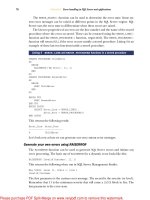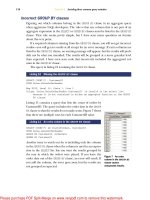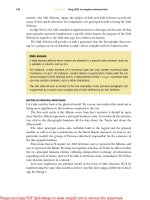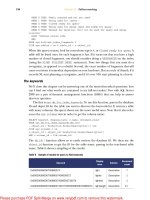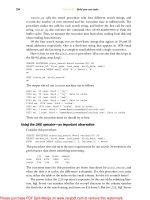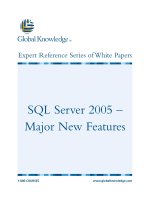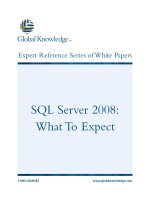Tài liệu SQL Server MVP Deep Dives- P16 docx
Bạn đang xem bản rút gọn của tài liệu. Xem và tải ngay bản đầy đủ của tài liệu tại đây (980.91 KB, 40 trang )
554
C
HAPTER
42
Tracing the deadlock
frame procname=WF.dbo.ViewThread line=20 stmtstart=1090
➥
stmtend=1362
➥
sqlhandle=0x03000600b15244168cf9db002b9b00000100000000000000
This section lists the full three-part name of the procedure that the process was run-
ning. If the call was ad hoc
SQL
, rather than a stored procedure, then the
procname
will read
adhoc
. The line number indicates on which line of the procedure the spe-
cific
SQL
statement starts. If the line number is 1, it’s a strong indication that the
specific
SQL
statement is a piece of dynamic
SQL
.
The statement start and statement end values specify the offsets within the proce-
dure where the query starts and ends. The
sql_handle
can be used with the
sys.dm_exec_sql_text
DMF
to get the
SQL
statement from the server’s procedure
cache. This usually isn’t necessary, as most of the time the statement is reproduced in
full in the deadlock graph right below this line.
The input buffer lists either the entire query (for ad hoc
SQL
) or the database
ID
and object
ID
for a stored procedure:
inputbuf Proc [Database Id = 6 Object Id = 373576369]
The object
ID
can be translated back to an object name using the object name
function:
SELECT OBJECT_NAME(373576369, 6)
In this case it returns
ViewThread
, matching what was shown for the process name ear-
lier in the deadlock graph.
NOTE
The
Object_Name
function took only one parameter, the object
ID
, prior
to
SQL
Server 2005
SP2
. From
SP2
onward, it accepts an optional second
parameter, the database
ID
.
The second process listed in the deadlock graph contains the same information and
can be read in much the same way. I won’t go through it all in detail, as many of the
explanations given for the first process apply to the second as well.
The second process has a different
waitresource
than the first one did. In the
case of the key lock, it was trivial to identify the table involved. The second process was
waiting on a page lock.
process id=process809f8748 waitresource=PAGE: 6:1:351 spid=55
The numbers listed for the page indicate database
ID
(6), file
ID
(1), and page
ID
(351). The object that owns the page can be identified using
DBCC PAGE
, but in this
case, it’s not necessary, as the name of the table is given later in the deadlock graph in
the list of resources. If
DBCC Page
were to be used, it would show that the page 6:1:351
belongs to a table with the ID 85575343. Using the
Object_Name
function reveals that
the table’s name is
Threads
.
The procedure that the second process was running is
WF.dbo.ViewForum
and the
statement began on line 9.
Licensed to Kerri Ross <>
Please purchase PDF Split-Merge on www.verypdf.com to remove this watermark.
555
Deadlock graph
By this point, we have a fairly clear idea as to what was happening when the deadlock
occurred.
The process with a session
ID
of 53 requested a shared lock on the index key
6:72057594038845440 (1900f638aaf3), in the Users table, so that it could run a select
that starts on line 20 of the procedure
ViewThread
. The second process, with a session
ID of 55, requested a shared lock on the page 6:1:351 belonging to the Threads table
so that it could run a select that starts on line 9 of the procedure
ViewForum
.
The resource list
What we don't know yet is what locks these two processes were holding when the dead-
lock occurred. That’s where the third part of the deadlock graph—the resource
list—comes in. The resource list lists all of the locks involved in the deadlock, along
with which process had them and which process wanted them.
The first entry in the resource list refers to the key lock on the primary key of the
Users table. We know, from the first section of the deadlock graph, that this is what
session
ID
53 was waiting for:
keylock hobtid=72057594038845440 dbid=6
➥
objectname=WF.dbo.Users indexname=PK__Users
➥
id=lock800c0f00 mode=X associatedObjectId=72057594038845440
owner-list
owner id=process809f8748 mode=X
waiter-list
waiter id=process803294c8 mode=S requestType=wait
Process process809f8748, which is session
ID
55, owned that lock in exclusive mode.
Process process803294c8 requested the lock in shared mode and had to wait.
The second entry in the resource list refers to the page lock on the Threads table.
We know from the first section that this is what session
ID
55 was waiting for:
DBCC PAGE
DBCC Page
is an undocumented but well-known command that shows the contents
of database pages. The command takes four parameters, the last being optional. The
first three are the database
ID
or database name, the file
ID
, and the page
ID
. The
last parameter indicates the print options.
Among the information that can be retrieved from the file header is the object and
index that the page belongs to (if it’s a data or index page).
To return the results to a query window, trace flag 3604 has to be enabled. An exam-
ple use of
DBCC
Page would be
DBCC TRACEON (3604)
DBCC PAGE (1,1,215,0)
DBCC TRACEOFF(3604)
Licensed to Kerri Ross <>
Please purchase PDF Split-Merge on www.verypdf.com to remove this watermark.
556
C
HAPTER
42
Tracing the deadlock
pagelock fileid=1 pageid=351 dbid=6 objectname=WF.dbo.Threads
➥
id=lock83255f80 mode=IX associatedObjectId=72057594038910976
owner-list
owner id=process803294c8 mode=IX
waiter-list
waiter id=process809f8748 mode=S requestType=wait
The process process803294c8, which is session
ID
53, owned that resource in intent-
exclusive mode and hence process process809f8748 (session
ID
55) had to wait.
NOTE
An intent-exclusive (
IX
) lock is taken by a process before an exclusive lock
and at a lower level of lock granularity, and is taken to signal the inten-
tion to take an exclusive lock; hence the name.
The two most common values for
requestType
are
wait
and
convert
. A value of
wait
indicates that a new lock has been requested;
convert
indicates that the process
already has a lock on that resource in one mode and requested to convert the lock
into a different mode. A typical example would be when a process has a shared lock
and wishes to convert it to exclusive. The conversion can only occur if there are no
locks on the resource that are incompatible with the new lock mode—for example in
the repeatable read isolation level, where a row is selected and then updated within a
transaction.
The big picture
Now the full picture of the events that lead up to and resulted in the deadlock is clear.
The process with a session
ID
of 53, while running the procedure
ViewThread
,
began an explicit transaction and did a data modification on the Threads table. Later
in the same transaction, it tried to do a select on the Users table, which was blocked.
The second process, session
ID
55, ran the procedure
ViewForum
. Within the proce-
dure, it began an explicit transaction and did a data modification on the Users table.
Following that, it attempted to run a select on the Threads table, which was blocked.
This deadlock turns out to be a case of objects accessed in different orders from
different places. Although fixing the code is beyond the scope of this chapter, it turns
out that reordering the queries in one of those procedures, so that the objects are
accessed in the same order in both, prevents the deadlock completely.
Changing the isolation level to
Snapshot
or
Read
Committed
Snapshot
will also pre-
vent the deadlock, because in the optimistic concurrency model, writers don’t block
readers. Again, a discussion on snapshot isolation is beyond the scope of this chapter.
Summary
The deadlock graph is the key to understanding and resolving deadlocks. The list of
resources locked shows the state of events before the deadlock. The information pro-
vided about the process’s state at the time of the deadlock, including locks requested
and the process’s input buffers, shows the cause of the deadlock clearly.
Licensed to Kerri Ross <>
Please purchase PDF Split-Merge on www.verypdf.com to remove this watermark.
557
Summary
About the author
Gail is a database consultant from Johannesburg, South Africa,
specializing in performance tuning and database optimization.
Before moving to consulting, she worked at a large South Afri-
can investment bank and was responsible for the performance
of the major systems there.
She was awarded
MVP
for
SQL
Server in July 2008 and spoke
at both TechEd South Africa and the
PASS
Community Summit
in Seattle in the same year. She’s a frequent poster on the
SQLServerCentral forums and has written a number of articles
for the same site.
Licensed to Kerri Ross <>
Please purchase PDF Split-Merge on www.verypdf.com to remove this watermark.
558
43 How to optimize tempdb
performance
Brad M. McGehee
Although most DBAs know about the tempdb database, many seem to think of it as
a black box that takes care of itself with no involvement required from the
DBA
.
Although this may be true on smaller, less active
SQL
Server instances, tempdb can
significantly affect
SQL
Server’s performance.
DBA
s can act to ensure that tempdb
performance is optimized and to optimize the overall performance of
SQL
Server.
What is tempdb used for?
The tempdb database is one of
SQL
Server’s included system databases and is used
as a shared temporary workspace for many different kinds of activities, such as the
following:
Storing user objects, such as temporary local and global tables and indexes,
temporary stored procedures, table variables, and the cursor.
Storing temporary work tables used for hash joins, aggregations, cursors,
and spool operations, and temporarily storing large objects; storing inter-
mediate sort results from many different internal operations, such as creat-
ing or rebuilding indexes, in addition to some
GROUP
BY
,
ORDER
BY
, and
UNION
queries.
Storing objects used when using
AFTER
triggers and
INSTEAD
OF
triggers.
Storing large
XML
objects.
Storing the
SQL
Server version store (
SQL
Server 2005/2008), which
includes the common version store and the online-index-build version store
(Enterprise Edition).
Storing intermediate results and sorting activity used during
DBCC
CHECKDB
operations.
Storing temporary objects for Service Broker.
Licensed to Kerri Ross <>
Please purchase PDF Split-Merge on www.verypdf.com to remove this watermark.
559
How DBAs can help optimize tempdb
If your
SQL
Server instance is not busy, and it doesn’t employ many of the activities
described previously, then tempdb performance may not be a problem for you. On
the other hand, if any of your
SQL
Server instances are busy, and are heavily involved
in many, if not most, of the previously described activities, then you may find that
tempdb can become a significant bottleneck for your entire
SQL
Server instance.
Tempdb internals
Unlike other
SQL
Server databases, the tempdb database is dropped and re-created
every time the
SQL
Server service is stopped and restarted. Here’s what happens.
When the
SQL
Server service is started, by default,
SQL
Server makes a copy of the
model database to create a new 8
MB
tempdb database, inheriting customizations
made to the model database. In addition, a transaction log file of 1
MB
is created. For
both the
MDF
and the
LDF
files, autogrowth is set to grow by 10 percent with unre-
stricted growth. Each
SQL
Server instance may have only one tempdb database.
In addition, tempdb exhibits many behaviors that don’t occur with other
SQL
Server databases. For example, tempdb is configured to run using the simple recovery
model, and this setting cannot be changed. In addition, many database options, such
as
Online
,
Read Write
,
Auto Close
,
Auto Shrink
, and others are preset and cannot
be modified. The tempdb database has many other restrictions including the follow-
ing: it can’t be dropped; it can’t be captured in a database snapshot; it can’t partici-
pate in mirroring; and it can’t allow
DBCC
CHECKDB
to be run on it. And as you would
expect, neither the tempdb database nor its transaction log file can be backed up.
This makes sense, as tempdb is designed for temporary objects only, and is re-created
each time
SQL
Server restarts.
After tempdb has been created,
DBA
s can create objects in it just as in other data-
bases. As user-created or internal objects are added to tempdb, it will automatically
grow as necessary to whatever size is required to hold the objects. On servers with
heavy tempdb activity, tempdb can grow considerably.
As activity transpires in tempdb, transaction logging occurs, but somewhat differ-
ently than with other
SQL
Server databases. Operations performed within tempdb are
minimally logged, which means that only enough information is logged so that tem-
porary objects can be rolled back, if necessary. Minimal logging helps to reduce the
overhead put on the
SQL
Server instance. Because the database is set to the simple
recovery mode, the transaction log is truncated constantly.
How DBAs can help optimize tempdb
As I mentioned previously, if your
SQL
Server instance doesn’t use tempdb much, then
tempdb performance may not be an issue for you. On the other hand, you should keep
one important thing in mind about tempdb: there is only one tempdb database per
SQL
Server instance, and it can become a major bottleneck that can affect the entire
performance of your
SQL
Server. Keep in mind that even if most of your applications
and databases behave well, a single misbehaving application and database can affect
the performance of all the other databases running on the same server.
Licensed to Kerri Ross <>
Please purchase PDF Split-Merge on www.verypdf.com to remove this watermark.
560
C
HAPTER
43
How to optimize tempdb performance
When building a new
SQL
Server instance, it is often difficult to determine how
busy the tempdb database will be in production. Because of this, you may want to con-
sider implementing many of the following suggestions when you build a new instance,
as in many cases it is much easier to implement these recommendations when the
server is first built, rather than trying to implement them after a problem has devel-
oped. Consider this as an ounce of prevention to avoid potential and unforeseen
problems in the future.
In the following section, we take a look at many different practices you can employ
to help optimize the performance of tempdb. Because each
SQL
Server instance is dif-
ferent, I am not suggesting that you employ every one of these recommendations on
each of your
SQL
Servers. Instead, you must evaluate the kinds of problems you are
having (or may have, if you are building a new
SQL
Server) and consider the available
options (for example, you may not have the option to reconfigure your storage array
or purchase new hardware). You implement only those recommendations that best
meet your needs.
Minimizing the use of tempdb
As we discussed earlier, a lot of activity can occur in tempdb. In some cases, you can
take steps to reduce
SQL
Server use of tempdb, helping to boost overall
SQL
Server
performance. Although this is not a comprehensive list, here are some actions you
may want to avoid:
Using user-created temp tables. Often, I have seen
T-SQL
code that creates
temp tables unnecessarily when the code could have been written to perform
the same task without using temp tables. If you have to use a temp table, and
the table has several thousand rows and is accessed frequently, consider adding
an index to the table to boost performance of queries that are run against it.
You may have to experiment with indexing to see if it helps or hurts overall
performance.
Scheduling jobs, such as
DBCC
CHECKDB
, that use tempdb heavily, at times of the
day when the
SQL
Server instance is busy.
Using static- and keyset-driven cursors. In many cases, cursors can be avoided by
rewriting the code.
Using recursive common table expression queries. If the execution plan for
such a query shows a spool operator, then you know that tempdb is being used
to execute it.
Using the
SORT_IN_TEMPDB
option when creating or rebuilding an index. Or if
you decide to use this option, schedule the job to run during a less busy time of
the day.
Using online index rebuilding (Enterprise Edition), which uses row versioning
and, in turn, uses tempdb.
Using large object data types.
Using table variables.
Licensed to Kerri Ross <>
Please purchase PDF Split-Merge on www.verypdf.com to remove this watermark.
561
Minimizing the use of tempdb
Returning and sorting excessive amounts of data. Smaller sorts can be done in
memory, but larger sorts spill over into tempdb.
Returning and aggregating excessive amounts of data.
Using joins that indicate a hash-type join in the query’s execution plan.
Using
AFTER
and
INSTEAD OF
triggers.
Using row-versioning-based transaction isolation levels.
You may know that you can’t avoid using the features in the previous list. If that’s the
case, then use them. Be aware that each of the choices in the list directly impact
tempdb’s performance. If you are having tempdb bottleneck issues and can’t reduce
the activity occurring in tempdb, you will have to resort to using some of the other
tempdb optimization suggestions in this chapter instead.
Preallocating tempdb space and avoiding use of autogrowth
Every time
SQL
Server restarts using its default settings, a new 8
MB
copy of tempdb is
created (regardless of the model database’s size), and autogrowth is set to 10 percent
with unrestricted growth. Other than for the smallest
SQL
Server instances, 8
MB
is
rarely large enough, and because of this, tempdb must grow on demand to whatever
size is necessary for your
SQL
Server instance to continue functioning. As you might
expect, allowing autogrowth to size tempdb can often be problematic.
For example, let’s say that the average size for tempdb for a particular
SQL
Server
instance is 1
GB
. In this case, when
SQL
Server is restarted, the initial size of tempdb is
8
MB
. Soon thereafter, autogrowth kicks in and grows tempdb 10 percent, over and
over again, until it reaches its optimal size of about 1
GB
. This can result in auto-
growth kicking in at busy times of the day, using up valuable server resources; and
delaying transactions from completing because autogrowth has to complete before
the transaction can complete. In addition, the use of autogrowth contributes to physi-
cal file fragmentation on disk, which can put extra stress on your disk
I/O
subsystem.
Instead of using autogrowth to manage tempdb sizing, use
ALTER
DATABASE
to
change the tempdb’s
MDF
and
LDF
files to their optimal size. This way, when the
SQL
Server service is restarted, tempdb will be sized correctly right away. Additional perfor-
mance gains can be achieved if you are using instant file initialization for your
SQL
Server instance, as this feature can dramatically decrease the time it takes for tempdb
to be created when
SQL
Server is restarted, or when autogrowth events occur.
The difficult part is determining the optimal size of tempdb for a particular
SQL
Server instance. Although Books Online offers a way to estimate the normal size of
tempdb, in practice, this is difficult to do. Personally, I start with an initial guess for
the size (based on similar servers I am managing) and then watch the tempdb size
over time. At some point, you should notice that tempdb is not growing, or that the
amount of space you have allocated is not being fully used. Based on this information,
I round this number up (the maximum amount of tempdb space actually used) to the
nearest GB and use that figure as the optimal size for my tempdb database. This
Licensed to Kerri Ross <>
Please purchase PDF Split-Merge on www.verypdf.com to remove this watermark.
562
C
HAPTER
43
How to optimize tempdb performance
applies to both the
MDF
and
LDF
files. I still leave autogrowth on, as something unex-
pected may come up, and I want tempdb to grow if it needs to.
After a particular
SQL
Server instance’s tempdb has been set, every time
SQL
Server is restarted, an optimum-sized tempdb will be created in one fell swoop, and
you won’t have to worry about the potential downsides of using autogrowth to size
tempdb.
Don’t shrink tempdb if you don’t need to
After you have established the optimal size of tempdb, you may notice that the actual
space used within tempdb varies considerably. Sometimes it may be less than half
used, and other times it may be virtually full. For example, your tempdb database may
be set to 1
GB
(its optimal size), but sometimes only 250
MB
of the allocated space is
used, whereas at other times 950
MB
of the allocated space is used. This is normal
behavior, as the amount of space used in tempdb varies depending on what is happen-
ing on the
SQL
Server instance.
Don’t let this varying amount of space trick you into considering shrinking tempdb
when space usage drops. If you do, you will be using
SQL
Server resources unnecessar-
ily and contribute to worse overall performance. For example, let’s say that on a Fri-
day you notice that your 1
GB
of tempdb database is only using 250
MB
, so you decide
to shrink the tempdb database from 1
GB
to 250
MB
to recover disk space. But on Sat-
urday, a series of weekly jobs runs that causes the now-250-
MB
-tempdb database to
grow back to 1
GB
using the autogrowth feature. In this case, all the resources
required to shrink the tempdb database, and the resources to autogrow the database,
will have been wasted.
In some cases, a wild-running query will cause tempdb to grow much larger than
its normal size. If you are short on disk space and want to reclaim this empty space,
and you are fairly confident that the wild-running query won’t repeat itself, you have
two choices:
Shrink the database and log files manually using
DBCC
SHRINKFILE
. This option
may not work as expected, as internal objects or the version store aren’t moved
during this process, often resulting in less than expected shrinkage.
Restart the
SQL
Server instance. This will re-create tempdb at the size it was as
specified by the
ALTER
DATABASE
statement. This option is more effective, but
you must have downtime available for it to work.
Think of a tempdb’s optimum size as its maximum size. If you keep this in mind, then
you won’t be tempted to shrink it when it is less than full.
Dividing tempdb among multiple physical files
Although there can only be one tempdb database per
SQL
Server instance, the
tempdb database can be split into multiple physical files. If your tempdb is not active,
then splitting it into multiple files may not buy you much additional performance. But
Licensed to Kerri Ross <>
Please purchase PDF Split-Merge on www.verypdf.com to remove this watermark.
563
Minimizing the use of tempdb
if your tempdb is active, splitting it into multiple files can potentially boost your
server’s overall performance.
Unfortunately, selecting the ideal number of physical files needed to optimize
tempdb’s performance is not an exact science. As a starting point, you should con-
sider creating as many physical files as there are
CPU
cores available to your
SQL
Server instance. For example, if your server has 8
CPU
cores available to it, then divide
the tempdb database into 8 physical files.
NOTE
If you decide to use multiple files for tempdb, it is important that each of
them be exactly the same size (for example, if your tempdb’s normal size
is 1 GB, then you should have 8 physical files of 125 MB each). This is
because SQL Server uses a proportional fill strategy to fill the physical
files. In addition, the autogrowth settings should be identical for each
physical file in order to ensure that each physical file grows identically.
Multiple files can boost disk
I/O
performance and reduce contention by spreading
I/O
activity over multiple files. This is beneficial even if the multiple files reside on a
single disk volume, although locating each physical tempdb file on its own disk vol-
ume would generally provide an even greater benefit (at a much greater cost).
On the other hand, using more physical disk files can increase switching costs and
file management overhead because each object created in tempdb will have to have
IAM
pages created in each of the physical files. This and other unknowns about your
SQL
Server instance complicate providing an exact recommendation for the optimum
number of physical files to use for your tempdb. I recommend that you perform tests
in your own environment to determine the number of physical files that optimize the
tempdb for your particular needs. After testing, you may find that more or fewer
tempdb physical files are needed for optimum performance.
Although the tempdb
MDF
file should generally be split into multiple physical
files, this is not the case with the tempdb
LDF
file. Because tempdb uses the simple
recovery model, and because it uses it own optimized logging method, dividing the
LDF
file into multiple physical files rarely provides any benefit.
Moving tempdb to a disk separate from your other databases
By default, when installing
SQL
Server, tempdb is stored in the same location as the
rest of your databases. Although this may work for smaller, less busy
SQL
Servers, it can
cause a lot of
I/O
contention problems on busy
SQL
Servers. Ideally, tempdb should
be located on its own disk volume(s), separate from other disk activity.
Locating tempdb on a fast I/O subsystem
No matter where tempdb is located, it should be located on the fastest
I/O
subsystem
available to your
SQL
Server instance. Your hardware will limit what you can do, but
you might want to consider the following options, assuming your hardware (and bud-
get) permits:
Licensed to Kerri Ross <>
Please purchase PDF Split-Merge on www.verypdf.com to remove this watermark.
564
C
HAPTER
43
How to optimize tempdb performance
Avoid putting tempdb on a
RAID
5
I/O
subsystem, because tempdb is subject to
heavy writes, and
RAID
5 often offers poor write performance.
Instead, locate tempdb on a
RAID
1 or
RAID
10
I/O
subsystem, which offer bet-
ter write performance.
If your
SQL
Server instance is storing data on a storage area network (
SAN
),
consult with your
SAN
engineer to determine the best location for optimal per-
formance. As a general rule of thumb on
SAN
s, tempdb should be located on its
own logical unit number (
LUN
) with its own dedicated drives.
Adding RAM to your SQL server instance
Depending on the operation,
SQL
Server often tries to perform the action in the buf-
fer cache. If the space is insufficient, then the operation may be forced to use tempdb.
For example, whenever a sort is performed,
SQL
Server tries to perform it in the buffer
cache because that is the fastest way to perform a sort. But if the sort data is large, or if
the buffer cache does not have enough space, then the sorting is done in tempdb. This
not only slows down the sort; it also places additional overhead on tempdb.
One way to avoid this and similar problems is to add additional
RAM
to your
SQL
Server instance, so that these activities can be completed in the buffer cache without
using tempdb.
Using SQL Server 2008 transparent data encryption
In
SQL
Server 2008, if you turn on transparent data encryption (
TDE
) for any one
database on a
SQL
Server instance, then tempdb automatically becomes encrypted,
which can negatively affect the performance of all the databases on the server,
whether they are encrypted or not. Because
TDE
encrypts and decrypts data pages as
they are being moved between the buffer pool and disk,
CPU
utilization increases as
encryption and decryption occur. On a busy server with an active tempdb, this can sig-
nificantly boost
CPU
utilization, potentially hurting the overall performance of your
SQL
Server. If your tempdb database is busy, avoid using
TDE
. If you must use
TDE
for
security purposes, consider limiting the load on the instance, or consider using
beefed-up hardware—
CPU
, memory, and faster disk access—to help overcome the
encryption and decryption performance penalty.
Leaving auto create statistics and auto update statistics on
By default, the auto create statistics and auto update statistics database options are
turned on for tempdb. In most cases, don’t turn these options off, as
SQL
Server will
automatically create and update statistics as needed in temporary tables and indexes,
helping to boost performance of many operations performed on them.
Verifying CHECKSUM for SQL Server 2008
Although this is not a performance optimization suggestion, it is an important consid-
eration for tempdb integrity. Starting with
SQL
Server 2008, the
CHECKSUM
database
Licensed to Kerri Ross <>
Please purchase PDF Split-Merge on www.verypdf.com to remove this watermark.
565
Summary
option is turned on by default for tempdb during a new install. This feature helps to
ensure the integrity of the tempdb database. On the other hand, if you perform an in-
place upgrade from an older
SQL
Server instance to
SQL
Server 2008, the
CHECKSUM
database option will not be automatically enabled for you on tempdb. To be on the
safe side, you should manually enable the
CHECKSUM
database option on tempdb for
added data protection.
Summary
As a
DBA
, it is a good idea to learn about the tempdb database and how it affects your
SQL
Server instances’ performance. You may quickly learn that you have a tempdb
bottleneck and not even know it. If tempdb has become a bottleneck for your
SQL
Server, consider all your options and implement one at a time, beginning with the eas-
iest ones, and if they don’t resolve the bottleneck, consider the more difficult ones
until you have resolved the problem. And, before you implement any of the sugges-
tions in this chapter, it is a good idea to test them on a test platform.
About the author
Brad M. McGehee is an
MCSE+I
,
MCSD
, and
MCT
(former) with
a bachelor's degree in Economics and a master's in Business
Administration. Involved in the industry since 1982, Brad is cur-
rently the Director of
DBA
Education for Red Gate Software,
and is an accomplished Microsoft
SQL
Server
MVP
with over 14
years of experience with
SQL
Server and over 6 years of training
experience. Brad is a frequent speaker at
SQL
PASS
, European
PASS
,
SQL
Connections, SQLTeach, SQLBits,
SQL
Saturdays,
TechFests, Code Camps,
SQL
Server user groups, and other
industry seminars. He blogs at www.bradmcgehee.com
.
Licensed to Kerri Ross <>
Please purchase PDF Split-Merge on www.verypdf.com to remove this watermark.
566
44 Does the order of columns
in an index matter?
Joe Webb
A single column index is straightforward. You may have heard it compared to the
index in the back of a technical book. To find information in the book, say you
want to learn more about how
DBCC
INPUTBUFFER
is used, you look up
DBCC
INPUT-
BUFFER
in the index. The index doesn’t contain the information on
DBCC
INPUT-
BUFFER
; it has a pointer to the page where the command is described. You turn to
that page and read about it. This is a good analogy for a single column, nonclus-
tered index.
In Microsoft
SQL
Server, you can also create an index that contains more than
one column. This is known as a composite index. A good analogy for a composite
index is the telephone book.
Understanding the basics of composite indexes
A telephone book lists every individual in the local area who has a publicly available
telephone number. It’s organized not by one column, but by two: last name and
first name (ignoring the middle name that is sometimes listed but most often
treated as an extension of the person’s first name).
To look up someone in the telephone book, you first navigate to the last name
and then the first name. For example, to find Jake Smith, you first locate the
Smiths. Then within the Smiths, you find Jake.
SQL
Server can use composite indexes in a similar manner. Composite indexes
contain more than 1 column and can reference up to 16 columns from a single
table or view. The columns that compose a composite index can contain up to a
combined 900 bytes.
Let’s consider some examples. Assume you have a Customers table as described
in listing 1.
Licensed to Kerri Ross <>
Please purchase PDF Split-Merge on www.verypdf.com to remove this watermark.
567
Finding a specific row
CREATE TABLE Customers
(
Customer_ID INT NOT NULL IDENTITY(1,1)
,Last_Name VARCHAR(20) NOT NULL
,First_Name VARCHAR(20) NOT NULL
,Email_Address VARCHAR(50) NULL
);
The Customers table has a clustered index on Customer_ID and a nonclustered com-
posite index on the Last_Name, First_Name. These are expressed in listing 2.
CREATE CLUSTERED INDEX ix_Customer_ID
ON Customers(Customer_ID);
CREATE INDEX ix_Customer_Name
ON Customers(Last_Name, First_Name);
Finding a specific row
When we issue a query to
SQL
Server that retrieves data from the Customers table, the
SQL
Server query optimizer will consider the various retrieval methods at its disposal
and select the one it deems most appropriate. Listing 3 provides a query in which we
ask
SQL
Server to find a Customer named Jake Smith.
SELECT
Last_Name
,First_Name
,Email_Address
FROM
Customers
WHERE
Last_Name = 'Smith' AND
First_Name = 'Jake';
In the absence of an index,
SQL
Server would have to search through the entire
table looking for the rows that satisfy this query. Because we have created a nonclus-
tered index on the Last_Name and First_Name columns,
SQL
Server can use that
index to quickly navigate to the selected rows. Figure 1 shows the query execution
plan for the query.
In the figure, we can see that
SQL
Server used an
Index Seek
operation on the
nonclustered index named ix_Customer_Name to locate the rows selected by the
query. To retrieve the additional non-indexed columns (Email_Address), a
Key
Lookup
was used for each row. The results were put together in a nested
Loop
join and
returned to the client.
Listing 1 A sample Customers table
Listing 2 Creating indexes for the Customers table
Listing 3 Finding a specific Customer row by Last_Name, First_Name
Licensed to Kerri Ross <>
Please purchase PDF Split-Merge on www.verypdf.com to remove this watermark.
568
C
HAPTER
44
Does the order of columns in an index matter?
You may have noticed that the
WHERE
clause in listing 1 provides the columns in the
order that they appear in the ix_Customer_Name index. This is not a requirement in
order for
SQL
Server to be able to use the index. If we reversed the order of the col-
umns in the
WHERE
clause,
SQL
Server would still be able to use the index. But don’t
take my word for it. Let’s look at another example to prove that this is indeed the case.
Listing 4 shows the newly rewritten query that reverses the order of the columns in the
WHERE
clause.
SELECT
*
FROM
Customers
WHERE
First_Name = 'Jake' AND
Last_Name = 'Smith';
Issuing the query produces the query execution plan found in the figure 2 query exe-
cution plan for listing 4. The plan is identical to the prior example in which the
WHERE
clause listed the columns in order.
Listing 4 Finding a specific Customer row by First_Name, Last_Name
Figure 1 Query execution plan for listing 1
Licensed to Kerri Ross <>
Please purchase PDF Split-Merge on www.verypdf.com to remove this watermark.
569
Finding a last name
Finding a last name
In the prior example, we supplied values in the
WHERE
clause for both columns
defined in the ix_Customer_Name index. The index is based on Last_Name,
First_Name, and our query limited the results by providing a value for the Last_Name
column and for the First_Name column.
Although this makes intuitive sense, a composite index’s usefulness is not limited
to only those instances where this is true.
SQL
Server can use a composite index when
only some of the index’s columns are provided. For example, consider the query
depicted in listing 5.
SELECT
Last_Name
,First_Name
,Email_Address
FROM
Customers
WHERE
Last_Name = 'Smith';
This query is similar to our prior example; however, notice that the
WHERE
clause now
specifies only a Last_Name of Smith. We want to find all Smiths in our Customers table.
Looking at the query execution plan in figure 3 for the query specified in listing 5,
we see that
SQL
Server did indeed use the ix_Customer_Name composite index. It
Listing 5 Finding customers by Last_Name
Figure 2 Query execution plan for listing 4
Licensed to Kerri Ross <>
Please purchase PDF Split-Merge on www.verypdf.com to remove this watermark.


